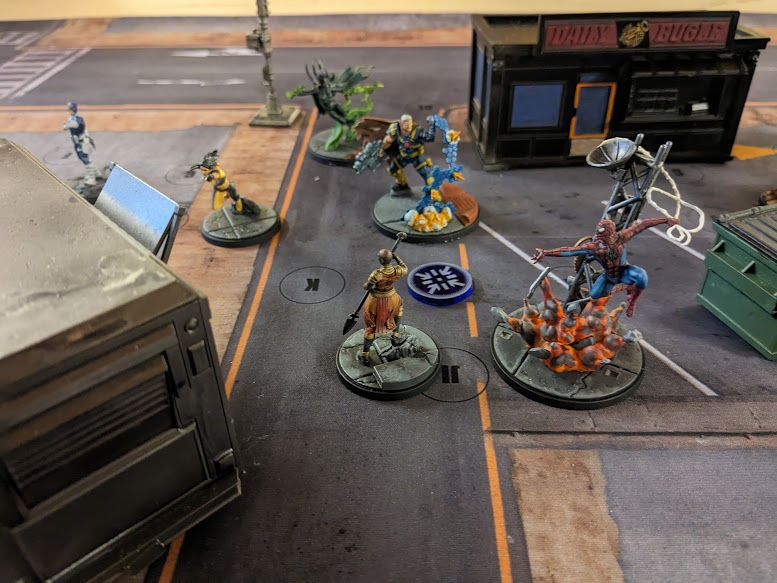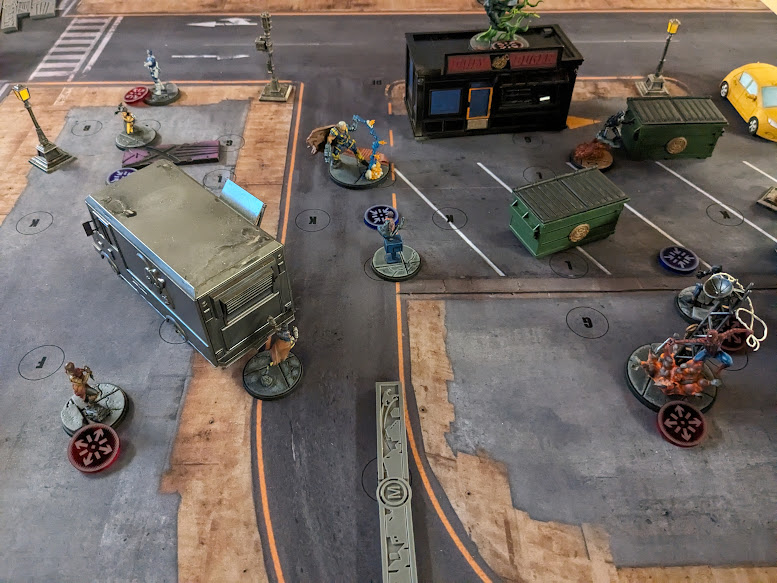
Welcome back to X-Ceptional Reading, the blog that takes its coffee like it takes its tactical analysis: homebrewed and of questionable quality.
One of the first questions Crisis Protocol players ask when learning the game is “how do I know which Crises to take in my list?” it’s a key element of the game, and isn’t immediately obvious to a newer player – or many experienced players.
The 4 pillars

There are actually pretty set elements of a crisis that can let you evaluate what teams might be better on it – and I think most players would agree they are, in no particular order
- Shape
- Threat Level
- Pace of scoring
- Crisis effects
The shape of the crisis determines where the action happens. The threat level determines how many models take part, and how “big” those models are. The pace of scoring determines how quickly the game can end. And the effects of the crisis add a wildcard, a spicy sauce to our crisis quesadilla.
When you apply these considerations, you can start to see why certain teams take certain crises. Take X-Force as an example. Deadly Meteors has a shape that brings people into the middle, which makes them easy to shoot – that’s X-Force’s favourite thing! It has a threat level of 17, which allows Cable to bring 2 affiliated 3 threats alongside a 2 and a 4 – perfect for getting the most rerolls out of the leadership and bringing the best affiliated models (Deadpool and X-23, I will brook no dissent here) to bear. There are only 3 points available a turn, and you have to roll to get them – that makes it hard for X-Force to get outscored before they can remove the opponent’s models. And the special effects slow the crisis (as mentioned) but also add incidental damage, making dazing models easier. Perfect!

Double trouble
It’s easy enough to evaluate a single crisis like this. It all gets rather more complicated when a second one is added – which is of course how we play the game! In our May tournament at Common Ground Games, TO Allan used a pre-set crisis format, secretly drawing crisis pairings from a pool for each round. Being forced to play unusual crisis combinations helped me get to grips with some thoughts if been having about crisis selections – particularly around the pace of scoring and why it matters. There’s quite a lot of material on map shape in MCP, so I wanted to focus on pace, because while less discussed I think it’s just as important.
At base, understanding scoring pace is simple: add up all of the points available from both crisis each turn. Divide that by 2 (as we assume each player will score half the points each turn). Then, divide 16 (the points required to win) by that number. That gives you an average number of turns a given game will last on that Crisis pairing.
Let’s stick with X-Force and Meteors here. Our wholesome, beloved X-Force player has drawn local bad guys Wakanda in round 1 of his tournament. He wins priority and picks his secures, flipping Meteors. His opponent flips Spider Infected. That makes 8 points total available a turn – pretty average, a little on the high side. If both players score 4 a turn, the game will reach 16 points after 4 rounds.

Reality bites
In reality, players are not going to sit looking at each other scoring points for 4 rounds- they will attempt to score more and make their opponent score less from the first turn. In our example, let’s say the squads are
Cable, Hela, X-23, Deadpool and Bullseye, vs Black Panther, Shuri, Okoye, Spiderman (Miles Morales) and Amazing Spiderman.
The most straightforward way round 1 plays out here is:
X-Force take the middle Extract with Hela, using an Eyes on the Prize grab. The teams then take turns picking up extracts until they are all gone, then begin flipping secures. If we assume everything goes with probability, Wakanda have the last activation, and flip the last point.
That leaves the score X-Force 4 (3 extracts, 1 Meteors) Wakanda 4 (2 extracts, 2 Meteors).
Breaker Breaker
That leaves the score at parity, which is something that comes up quite a bit – even scoring between the two teams. But both teams are built to break parity, albeit in different ways. X-Force plan on dazing then KOing characters, eventually scoring the majority of points on the board. Wakanda plan on scoring more points as quickly as possible (as we discussed last month).
So a more likely first round goes like this:
X-Force take the middle Spider Infected with Hela. Wakanda play Advanced RnD and Spirit of Wakanda to generate 2 extra power on everyone but Shuri, then Black Panther takes a nearby extract. Bullseye takes a nearby Spider Infected, then Amazing Spiderman uses Web Swing and moves Long to the remaining Spider Infected in the X-Force side, and moves Long away from Cable. X-Force can’t reach the remaining Spider Infected, so will be trying to daze Amazing Spiderman to achieve parity round 1 – a tall order at the best of times.

Flipping the script
From here, the play pattern is harder to predict. The opening script has been torn up and the decisions facing the X-Force player are much more complicated than in the first example. The point though is that parity has been broken and scoring advantage now sits with Wakanda. If they manage to establish a 5-3 lead and repeat that scoring pattern turns 2 and 3, they’ll be 15-9 up starting turn 4. That means if they can walk away to safety with just one extract, the absolute best the X-Force player can hope for is to score the other 7 points to force a tie and a round 4.
There are two points to take away from this: first, understanding the total number of points available let’s you understand how “fast” the game will be and who is advantaged. Second, different scoring tools help break parity and gain scoring advantage on different crises.
Wakanda can use the power gain from a turn one Spirit play to take extracts normally considered safe via Amazing Spiderman, Quicksilver, Black Cat or Spider-Woman. Actually, any long move or medium base medium move character can do this if positioned properly – it’s just that Cable will normally kill them immediately, whereas Spirit of Wakanda gives them the power to get away afterwards.

A similar play for secure scoring is available in Kingpin Criminal Syndicate, where often the Crims player will break parity round 1 by last activation double moving Black Cat on to one of his opponent’s home points, scoring it because of his leadership.
These two examples stand out because they happen on round one, and they really take players by surprise if they aren’t prepared. The norm though is for scenario teams to break parity in later rounds by using extract steals (like our naughty Wakandan in our example, splashing Miles Morales) or displacement (like Black Panther’s automatic push on his attack) to score Secures.
Parity breaks through superior firepower
Attrition teams often want to break parity and gain scoring advantage as well. However, they generally want to do this all at once, rather than incrementally scoring one or two more.
In an idea scenario for the X-Force player in our example, he *does* daze Amazing Spiderman, maintaining parity in scoring and accruing material advantage by flipping ASMs card. The plan then becomes: KO Amazing Spiderman, daze and KO a few other models and score all the points (or close) on the board, uncontested.
This plan will take several rounds to set up, and works best when you manage to KO several opposing characters, avoiding recriminations and permanently reducing scoring potential.
This is an extreme example – many attrition teams will win games by a few points and both players will be “in it” until the last round. The principle is true though – scenario teams want to accrue a scoring advantage as early as possible, bringing their round 3 score to 16. Attrition teams are concerned with reducing their opponent’s scoring potential until it is safe to focus on points without losing a race to 16.
The point of the points?
Is this applicable to game play and planning? Well, our example shows that the X-Force player was right to select Meteors instead of, say, Scoundrels. Scoundrels has a crisis effect that X-Force love – the Secures give Cover, which they benefit from but can ignore once a turn. That’s a strong advantage, and one that sometimes tempts X-Force players. But compare that to the impact on scoring pace – instead of 8 points, the total available is 10. That’s 5 each assuming parity, which means Wakanda only has to break parity once to score 16 turn 3. They can do that round one, as can Criminal Syndicate, with Hellfire Club and Web Warriors easily doing so round two. In my eyes, any crisis combination where a scoring team can easily reach 16 at the end of round 3 is very dangerous for attrition or mid-range teams.

The same argument can be made for extract selection. I enjoy playing Mutants Extremists Target US Senators in X-Force. It forces models into the middle of the map, and makes it harder for them to run away once there. However, it offers 6 points a round. If paired with a scoring teams secure – which will always provide 4 or even 5 points a turn – we can expect 10 or 11 points to be scored a round, meaning my opponent only needs to break parity once to score out round 3. That’s too high risk, and ultimately means Senators is probably not the correct choice for X-Force.
Planning for Parity
Understanding crisis pace helps with roster construction, but it also helps with in-game planning and decisions making. Knowing how many points are available helps understand what the game state will likely be at the end of round 1, which helps you predict what your opponent will do and possibly counter it.
For example, if our X-Force player is wise to the Wakandan opening play, he may be able to position Hela in a way that makes taking his back Spider Infected impossible (by placing Hela in a position that blocks ASM’s base from getting within R1 of the extract). Or he may chose to take Nick Fury Jr instead of Hela, picking up the centre and a back extract turn 1, preventing the play.
This continues throughout the game. If you know your Hellfire opponent is planning to use Rhino’s This Is A Robbery to break extract parity, you can play Mission Objective and position your extract holders within 2 of a teammate. If you know they need to use Bill to break Secure parity, by moving twice and throwing your character off a point, that means he’s likely to activate after your characters standing on secures (or they will simply walk back to the point). It also means you can use terrain or another model to block the path of the throw or Bill’s route to the secure. Or you can simply wait until the activation before Bill and displace or daze him.
Extractly what’s the difference?
To make my points I’m ignoring, to an extent, the difference between secure pacing and extract pacing. There are a few things to bear in mind here.
Extracts tend to be faster, simply because you can pick them up and run away, so they become “easier” to score more than once. Crises where a character can hold more than one extract are potentially even faster, as a single character can run away with two. That explains why some Web Warriors players prefer Hammers to Skrulls – Miles or Black Cat can pick up a Hammer turn one and still plan to steal in a later round. Finally, understanding pace on Researcher is tricky, other than “it’s very slow”. Scoring is determined by the movement of the extract and it’s position relative to the evac point, making it hard to predict. Add to that the fact that whoever brings researcher is focusing on attacking, not point scoring, and you get an atypical crisis that is hard to analyse beyond the basic observation that it’s slow and favours fighty teams.
Cleanup effects
There’s a lot to crisis selection, and scoring pace is a really key element to Crisis Protocol. I’ve likely missed things here and I’m sure there are contradicting opinions. There are though a few principles worth considering based on this stuff:
- Pick your crises on pace of scoring first – that’s what determines the type of game you’ll be playing. Shape matters a lot too, but they are very closely tied.
- Pick your best crisis, but think about your “least worst” options too. Senators plays to X-Force’s strengths, but ultimately it plays *more* to the strengths of the scoring teams
- Figure out what action would give your opponent the best chance of winning the game, then assume they’ll take it. Understanding their plan on the crisis combination you’re playing (based on how they score) will help you work out what their optimal play is. Then if they do something worse, you’re benefiting anyway.
That’s it for this month. I’ll likely step away from tactics and strategy next time out for a look at different painting approaches for events. However if AMG publish something incredible in the meantime, I may find myself distracted.
Thanks for reading, and be X-cellent to each other.



